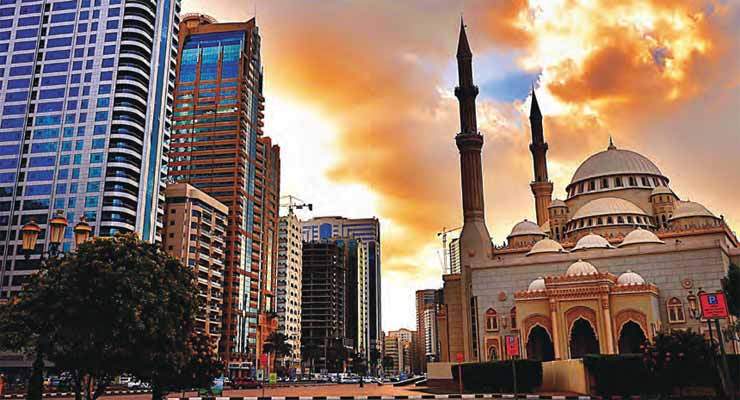TO ESTABLISH A STRONG PRESENCE ON THE MAP.
By 2021, when the UAE will be celebrating its 50th anniversary, Sharjah expects to attract 10 million visitors. In comparison, this is the same number that Dubai registered in 2012.
“Sharjah Tourism Vision 2021 aims to revolutionise the tourism experience in Sharjah and we are exhilarated to be a part of this journey,” said Michael Kasch, general manager, Centro Sharjah.
The vision builds on four main pillars; promoting the emirate as an ideal destination for families; following an innovative tourism approach; developing world-class facilities and capabilities; and further strengthening Sharjah’s position as an international cultural hub.
As H.E. Mohammed Ali Al Noman, chairman, Sharjah Commerce and Tourism Development Authority (SCTDA), noted, by tapping into the emirate’s historical and cultural tourism potential and leveraging its advanced infrastructure and innovative hospitality services, Sharjah has established itself on the global tourism map as a preferred destination for millions of visitors.
“Sharjah offers a unique tourism product which is developing at a fast pace,” highlighted Ahmed ElGharib, hotel in charge, Hilton Sharjah, admitting that the current economic climate, the increased UAE room inventory and the growing popularity of neighbouring emirates have created a competitive marketplace, yet Sharjah continues to evolve thanks to its family-friendly profile and a thriving cultural scene.
In 2014, nearly two million travellers flocked to the emirate, thus, achieving the proposed goals would mean multipyling guest numbers in just seven years.
This year has brought encouraging results with occupancy levels at Centro Sharjah standing at 90 percent, nevertheless, as Kasch noted, the devaluation of the Russian Ruble and the overall plunge in demand from CIS countries has had an impact on business growth.
This was also admitted by Kamal Rijhwani, executive assistant manager, sales and marketing, Radisson Blu Resort Sharjah, who said that this shift has given the hotel the opportunity to penetrate new markets and record improved volume of bookings from the GCC, Saudi Arabia, the UK, India, Kazakhstan as well as China.
A similar trend was reported by Alex Cherfan, operations manager, Golden Tulip Sharjah, who mentioned Eastern Europe, Far East, especially Malaysia and Indonesia, and again China as key markets that have helped make up for the losses from some traditionally strong sources.
In addition, as Cherfan disclosed, the management is also keen on increasing market share from countries such as India and Iran – the latter one being a relatively new focus for Sharjah –, by taking part in road shows along with SCTDA and Air Arabia.
In fact, these are also markets where SCTDA and Sharjah Development and Investment Authority (Shurooq) have been particularly active.
China is another key target market for Sharjah, especially since, as Rijhwani reminded, Air Arabia ventured into the Asian country at the beginning of the year.
As he further disclosed, Radisson Blu Resort Sharjah’s management continues to work hand in hand with the airline, with a key emphasis on attracting groups from Iran, while another focus is the Indian MICE sector.
Air Arabia indeed plays a major role in Sharjah’s evolvement, having established connections to three new destinations from the emirate so far this year.
Against the backdrop of challenging market conditions, the airline, now in its 12th year of operation, continues to deliver strong financial results as it also lays great emphasis on ensuring its long-term growth.
JOINING FORCES
Aligning both short- and long-term strategies remains a crucial element and Al Noman has recently called on all parties associated with the industry to form active partnerships.
“This is a goal that cannot be achieved by any particular sector on its own. […],” stressed Al Noman, who also pledged to add to the existing tourist attractions and build on the success of the current festivals and special events.
“We are also looking to expand tourist numbers through exhibitions and conferences and enhance Sharjah’s reputation as a major international cruise tourism destination in the region,” outlined Al Noman. “We will create advanced tourism infrastructure to offer an exceptional tourism experience that takes care of every requirement of visitors.”
One of the latest examples of the collaborative efforts is Air Arabia and Expo Centre Sharjah (ECS)’s partnership; a significant move, as Said Mohammed Al Midfa, CEO, ECS, said, which is aimed at maximising visibility and branding.
Through the three-year tie-up, the airline will advertise at the venue during events, in various catalogues as well as other channels and in turn, the carrier will highlight the destination’s events and capabilities.
“The memorandum of understanding will go a long way in promoting Sharjah and its economy, and add support to this important part of the economy,” said Adel Ali, group CEO, Air Arabia.
The deal is the latest in a string of similar joint endeavours, all of which are set to further strengthen the emirate’s standing as it continues, as ElGharib said, to explore new markets and display its attractions and capabilities to a wider audience.
“The roster of events planned throughout the year really aims to further consolidate Sharjah’s presence on the tourism map. In addition, the planned upcoming developments on Al Noor Island, the extension of Al Majaz Waterfront, increased number of hotels and the Kalba ecotourism project will only add to the emirate’s [appeal],” added ElGharib.
As Rijhwani explained, to achieve the emirate’s goals, Sharjah has already taken steps to boost its inventory to 15,000 rooms by 2021.
“Training is another huge factor. SCTDA has also launched a new training programme for developing the human resource capabilities in the hotel sector […]. Hotels in Sharjah will be positively impacted by the vision. This will lead to an overall increase in occupancy and result in a growth in average daily rate,” elaborated Rijhwani.
“Sharjah being a dry emirate, and with many family activities and events along with the opening of water parks, will be able to appeal to a wider pool of visitors,” concluded Rijhwani.
Kasch concurred, saying, “The anticipated growth will not only increase the size of the existing markets, but also create new ones [...] catering to each of the four pillars the vision is based on.”









